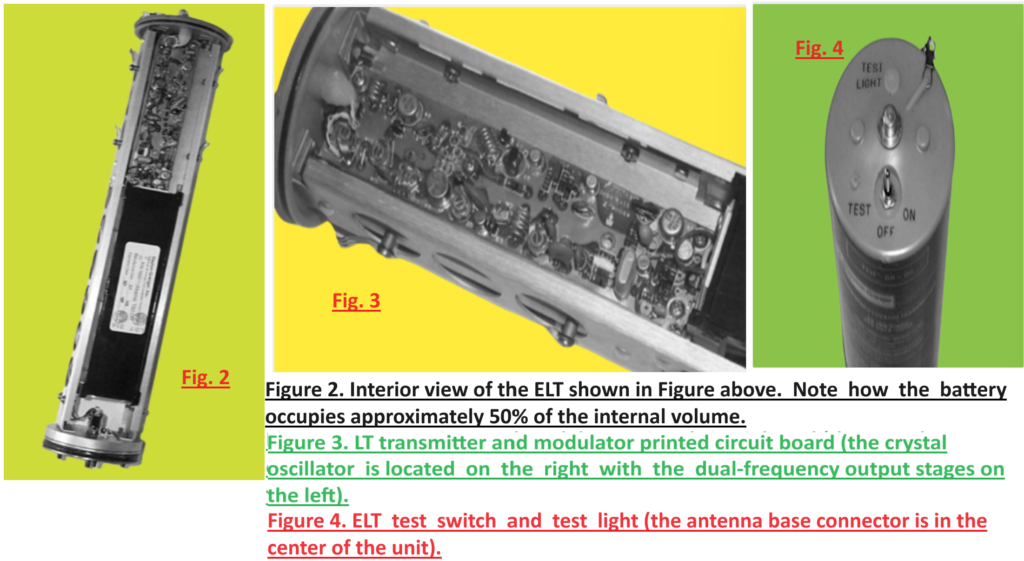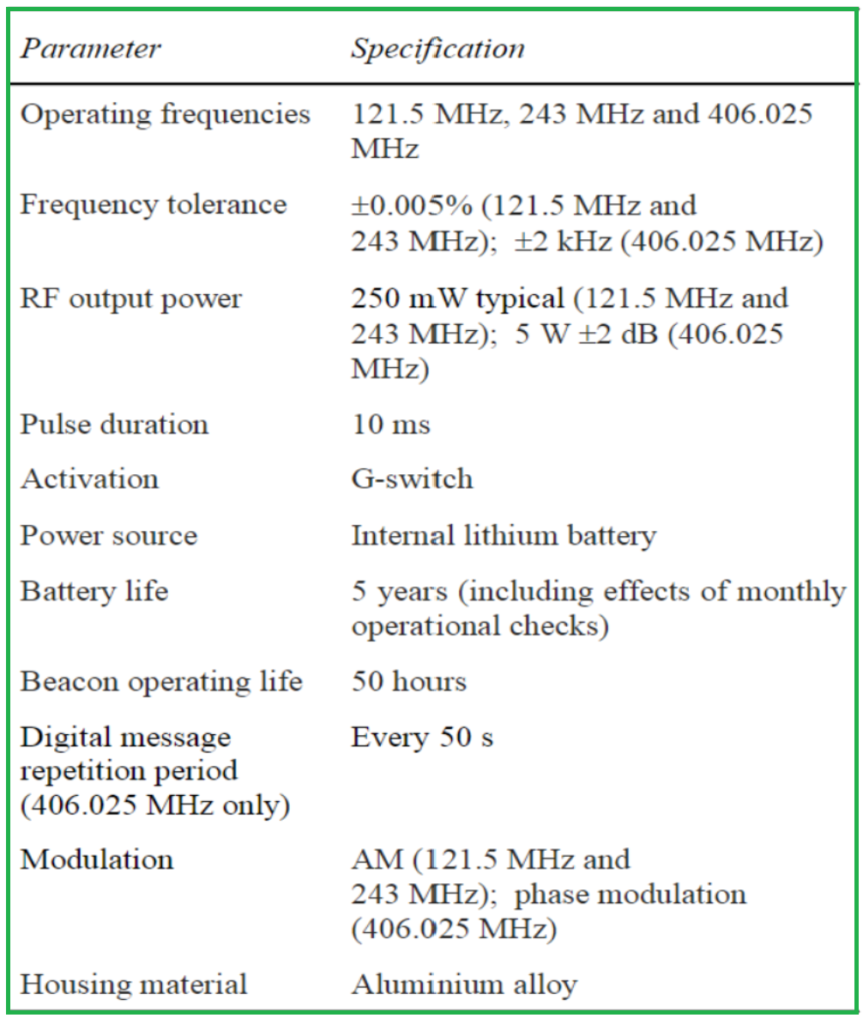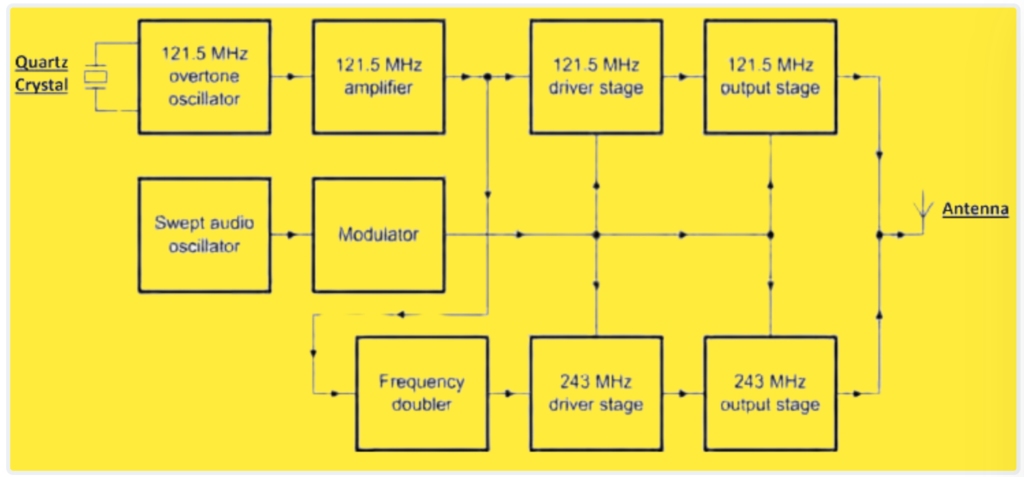Emergency Locator Transmitters (ELTs) are radio beacons that are installed on aircraft to facilitate the detection and location of the aircraft in the event of an emergency.
According to ICAO (International Civil Aviation Organization), an Emergency Locator Transmitter (ELT) is defined as equipment that broadcasts distinctive signals on designated frequencies and may be automatically activated by impact or manually activated, depending on the application.
Locating a crashed aircraft quickly is crucial for search and rescue teams and potential survivors. Studies reveal that if rescue is delayed beyond two days, initial survivors have less than a 10% chance of survival. However, if rescue occurs within eight hours, the survival rate increases to over 60%. That’s why most small aircraft are required to have emergency locator transmitters (ELTs). ELTs emit signals on specific radio frequencies, making it easier for search crews to find the aircraft and rescue survivors promptly. This chapter gives a simple introduction to the different types of ELTs and how they work on modern passenger planes.
Types of ELT (Emergency Locator Transmitter).
There are several types of ELTs currently in use, including older units that produce a modulated RF carrier on VHF frequencies used for distress beacons: 121.5 MHz and its second harmonic, 243.0 MHz. While 121.5 MHz is specified for civil aviation use, 243.0 MHz is often called the military aviation distress frequency. Some ELTs can transmit simultaneously on both frequencies with the help of a frequency doubler and dual-band output stage.
Simple VHF ELT devices generate an RF carrier modulated by a distinctive siren-like sound that sweeps downward at a repetition rate typically between 2 and 4 Hz. This signal can be easily detected by Sarsat and Cospas satellites or by any aircraft monitoring 121.5 MHz or 243.0 MHz.
More modern ELTs operate on a specific UHF frequency, such as 460.025 MHz. These devices are more sophisticated and operate at a significantly higher power (5 W instead of the 150 mW commonly used at VHF). Unlike the simple amplitude modulation used with their VHF counterparts, 460 MHz ELTs transmit digitally encoded data, which incorporates a unique code assigned to the aircraft carrying them.
Most ELTs, if properly maintained, are capable of continuous operation for up to 50 hours. However, it’s important to note that ELT performance, especially the operational range and duration for which the signal is maintained, may be seriously impaired when the batteries are out of date. Routine maintenance checks are therefore essential, and any ELT with outdated batteries should be considered unserviceable.
| Type | Class | Description |
| A or AD | Automatic ejectable or automatic deployable | The type of ELT you’re referring to is commonly known as a “deployable ELT” or “automatic deployable ELT.” These ELTs are designed to automatically eject from the aircraft upon impact or crash. They are activated by built-in inertia sensors that detect the crash deceleration force acting along the aircraft’s flight axis. Deployable ELTs are indeed more expensive and are not commonly used in general aviation due to their higher cost and complexity. They are more commonly found in commercial or larger aircraft where the cost can be justified by the increased safety measures and regulations. In general aviation, where cost is often a significant factor, fixed automatic ELTs with crash activation sensors are more prevalent. |
| F or AF | Fixed (non-ejectable) or automatic fixed | Fixed automatic ELTs are crucial safety devices mounted securely onto aircraft, designed to activate automatically upon crash or emergency. They employ an inertia switch sensitive to crash deceleration forces along the aircraft’s flight axis, triggering activation upon impact. This automatic feature significantly enhances their effectiveness in alerting search and rescue teams swiftly. These ELTs often offer manual activation and deactivation options, empowering the crew to take control in various emergency scenarios. Additionally, some models feature remote control capabilities from the cockpit, streamlining activation processes and enhancing coordination with authorities. Provisions are typically made for recharging ELT batteries from the aircraft’s electrical supply, ensuring continuous functionality. Regular maintenance and battery checks are crucial to maintain the ELT’s reliability and readiness for emergency situations. |
| AP | Automatic portable | The type of ELT described is similar to Type-F or AF ELTs, but with a key difference: the antenna is integral to the unit for portable operation. |
| P | Personnel activated | This type of ELT lacks fixed mounting and does not transmit automatically. Instead, it requires manual operation of a switch to activate or deactivate the transmitter. |
| W or S | Water-Activated ELT | A Water-Activated ELT is a specialized distress beacon designed to automatically transmit distress signals when submerged in water. It is typically used in maritime and aviation applications where rapid detection and alerting are crucial in emergency situations. |
Different types of ELTs are distinguished based on their application and activation method. Modern passenger aircraft may carry multiple types of ELTs. For instance, Figure below illustrates a typical Type-W (water-activated) survival ELT commonly found on modern transport aircraft.

In general aviation aircraft, most ELTs are of the automatic type. These fixed automatic units are equipped with a crash activation sensor, often referred to as a G-switch. This sensor detects the characteristic deceleration of a crash and automatically activates the transmitter.
With the current presence of Sarsat and Cospas satellites in orbit, ELT signals are typically detected within 90 minutes, alerting the appropriate search and rescue (SAR) agencies. Additionally, military aircrew monitor frequencies like 121.5 MHz or 243.0 MHz and notify air traffic services (ATS) or SAR agencies of any ELT transmissions they detect.
It’s important to note that the detection ranges for Type-W and Type-S ELTs can be improved by placing the ELT upright, with the antenna vertical, on the highest nearby point. Any accessible metal surface can act as a ground plane, and doubling the height can increase the range by about 40%.
Basic Construction of ELT.
Here’s a simplified explanation based on the provided text:
Type-W ELT Construction.
- Figures 1 to 4 illustrate the external and internal parts of a basic Type-W Emergency Locator Transmitter (ELT).
- The unit is designed to be sealed at each end to prevent water from entering.
- To disassemble the ELT for maintenance or repair, the unit is typically withdrawn from one end of the cylindrical enclosure. During reassembly, it’s crucial to ensure that the hermetic seals at each end of the enclosure are properly reinstated.

Specification for Type-AF ELT:
- This ELT model provides outputs on all three ELT beacon frequencies: 121.5 MHz, 243 MHz, and 406.025 MHz.
- It uses amplitude modulation (AM) on the VHF frequencies (121.5 MHz and 243 MHz) and phase modulation (PM) on the UHF frequency (406.025 MHz).
- The AM modulating signal consists of an audio tone that sweeps downward from 1.5 kHz to 500 Hz with three sweeps every second, with a modulation depth greater than 85%.
- Table below outlines the specifications for a modern Type-AF ELT.

Block Schematic Diagram for Type-W ELT.
- Figure 6 depicts a simplified block schematic diagram for a Type-W ELT.
- The power supply is connected via a water switch, although it’s not shown in the figure.
- This particular unit only provides outputs at VHF frequencies (121.5 MHz and 243 MHz). The 243 MHz signal is generated using a frequency doubler stage, as these two frequencies are harmonically related.

These explanations provide insights into the construction, specifications, and operation of Type-W and Type-AF ELTs, helping users understand their functionality and maintenance requirements.
Maintenance and Testing of ELT
ELT Maintenance and Testing Guidelines:
1. Regular Inspection.
ELTs should undergo regular inspections following the manufacturer’s recommendations. Ensure the ELT is securely mounted, free from external corrosion, and that antenna connections are tight. Check the battery expiry date indicated on the external label and only use approved battery types.
2. Air Testing Procedure.
Before activating the ELT, listen on the beacon’s output frequency (e.g., 121.5 MHz) to ensure it is not transmitting. Conduct air testing by activating the ELT and checking the radiated signal. Simple air tests between aircraft or between an aircraft and a ground station can suffice, but it’s essential to follow the manufacturer’s instructions for testing.
3. Two-Station Air Testing.
Preferably, conduct air testing with two stations, including a nearby ground station. This helps identify faults that may not be detected when using the aircraft’s own VHF receiver due to the proximity of the transmitting and receiving antennas.
4. Reporting Accidental Activations.
Accidental ELT activations must be reported promptly to the appropriate authorities, such as the nearest rescue coordination center. Provide the location of the transmitter and the time and duration of the accidental transmission. Timely reporting helps prevent unnecessary search and rescue missions.
5. Timing and Duration of Testing.
ELT testing should occur only during the first five minutes of any UTC hour and be restricted to a duration of no more than five seconds. Adhering to these time and duration limits minimizes interference and false alerts.
By following these maintenance and testing guidelines, operators can ensure the proper functioning of ELTs and minimize the risk of false activations, thereby enhancing aviation safety and reducing the likelihood of unnecessary search and rescue operations.
ELT Mounting Requirements.
Considerations for ELT Placement and Mounting in Aircraft:
- Orientation in Fixed Wing Aircraft: Install the ELT with its sensitive axis aligned in the direction of flight to optimize signal transmission.
- Orientation in Rotorcraft: In rotorcraft, mount the ELT with its sensitive axis approximately 45° downward from the normal forward direction of flight to enhance signal coverage.
- Inertia Forces: Ensure that the ELT installation can withstand ultimate inertia forces, including 10 g upward, 22.5 g downward, 45 g forward, and 7.5 g sideways forces, to prevent damage or dislodgement during flight or impact.
- Vibration: Choose a location for the ELT installation that minimizes vibration to prevent unintentional activation of the transmitter.
- Protection from Damage: Mount the ELT in a location that reduces the risk of damage from fire or crushing in the event of a crash impact, thus ensuring its functionality during emergencies.
- Accessibility: The ELT should be easily accessible for manual activation and deactivation. If equipped with a portable operation antenna, ensure that the ELT can be detached easily from inside the aircraft.
- Marking: Clearly mark the external surface of the aircraft to indicate the location of the ELT, facilitating quick identification for maintenance or emergency response purposes.
- Remote Operation Notices: If the ELT has provisions for remote operation, display appropriate notices to inform personnel about its capabilities and procedures for activation. This ensures that remote operation is conducted correctly in emergency situations.
By following above points, aircraft operators can ensure the effective placement and mounting of ELTs, thereby enhancing their reliability and readiness for operation in case of emergencies.
Requirements for the Antenna Used by a Fixed Type of ELT:
- Avoidance of Shared Antennas: The ELT should have its dedicated antenna and should not share the antenna of any other avionics system. This ensures optimal performance and minimizes interference.
- Distance from VHF Antennas: Mount the ELT antenna as far away as possible from other very high frequency (VHF) antennas to prevent interference and maintain signal integrity.
- Compliance with Manufacturer’s Instructions: Ensure that the distance between the ELT transmitter and antenna complies with the installation instructions provided by the ELT manufacturer or other approved data sources. This helps optimize signal transmission and reception.
- Omnidirectional Radiation: Position the antenna to ensure essentially omnidirectional radiation characteristics when the aircraft is in its normal ground or water attitude. This ensures that distress signals can be transmitted and received from all directions.
- Aft Mounting: Mount the ELT antenna as far aft (rear) as possible on the aircraft to minimize the risk of damage and interference from other equipment or structures.
- Avoid Contact with Other Antennas: Ensure that the ELT antenna does not foul or make contact with any other antennas during flight. This prevents damage to the antenna and maintains clear signal transmission and reception.
Mounting and installation of considerations for Type-W and Type-S ELTs:
- Installation Similar to Type-F: Install Type-W and Type-S ELTs similarly to Type-F ELTs, but with a means of quick release for rapid removal. Locate the ELT as close to an exit as possible without obstructing or posing a hazard to aircraft occupants.
- Accessibility: In cases where regulations require the carriage of a single Type-W or Type-S ELT, ensure that it is readily accessible to passengers and crew. This accessibility ensures quick access to the ELT in case of an emergency.
- Placement of Second ELT: If regulations require the carriage of a second Type-W or Type-S ELT, locate it near a life raft pack or attach it to a life raft in a way that ensures it is available or retrievable when the raft is inflated. This placement ensures that the second ELT is easily accessible in the event of a water landing or emergency evacuation.
- Battery Safety: If an ELT is equipped with a lithium or magnesium battery, do not pack it inside a life raft in an aircraft. This precaution helps prevent potential hazards associated with these types of batteries, such as fire or explosion risk.
By following these points considerations, operators can ensure the effective installation and placement of Type-W and Type-S ELTs, maximizing their accessibility and functionality in emergency situations.